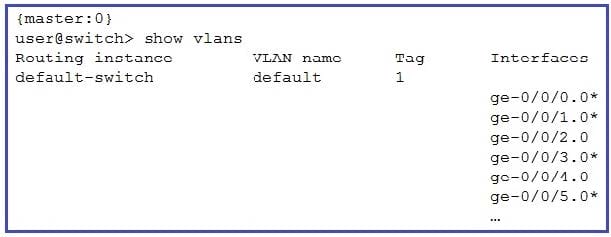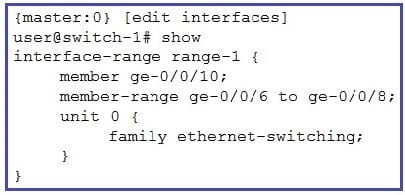Exam Details
Exam Code
:JN0-349Exam Name
:Enterprise Routing and Switching, Specialist (JNCIS-ENT)Certification
:Juniper CertificationsVendor
:JuniperTotal Questions
:110 Q&AsLast Updated
:Mar 25, 2025
Juniper Juniper Certifications JN0-349 Questions & Answers
-
Question 81:
Which mechanism is used to share routes between routing tables?
A. RIB groups
B. routing instances
C. forwarding instances
D. filter-based forwarding
-
Question 82:
Which two statements about a unified ISSU are correct? (Choose two.)
A. It requires that Bidirectional Forwarding Detection be disabled.
B. It requires that graceful Routing Engine switchover be enabled.
C. It is only supported on platforms with redundant control planes.
D. It is only supported on platforms with redundant power supplies.
-
Question 83:
What are three requirements to ensure proper GRE or IP-IP tunnel routing? (Choose three.)
A. Keepalives must be used on stateless tunneling protocols.
B. Tunnel endpoints must have a route that directs traffic into the tunnel.
C. BGP must be used on intermediate devices.
D. Tunnel endpoints must have a valid route to the remote endpoint.
E. All intermediary devices must have a route to the tunnel endpoints.
-
Question 84:
Click the Exhibit button.

Referring to the exhibit, what does the asterisk(*) following the ge-0/0/5.0 interface indicate?
A. It indicates the interface is not active.
B. It indicates the interface is a trunk port.
C. It indicates the interface is an access port.
D. It indicates the interface is active.
-
Question 85:
Your BGP router receives routes from two upstream ISPs: ISP A and ISP B. In this scenario, which change would you make to prefer routes from ISP A?
A. Set the local-preference attribute for all routes received from ISP A to 200 while all routes received from ISP B use the default local-preference value of 100.
B. Prepend the AS path to all routes received from ISP A while all routes received from ISP B use the default AS path value.
C. Change the MED value for all routes received from ISP A to 1 while all routes from ISP B remain configured with no MED value.
D. Set the local-preference attribute for all routes received from ISP A to 50 while all routes received from ISP B use the default local-preference value of 100.
-
Question 86:
Which two statements about Layer 2 loop prevention protocols are correct? (Choose two.)
A. RSTP distributes the current tree topology using the root bridge.
B. STP can take 30 to 50 seconds to respond to a topology change.
C. RSTP can take 30 to 50 seconds to respond to a topology change.
D. STP distributes the current tree topology using the root bridge.
-
Question 87:
Click the Exhibit button.

Referring to the exhibit, which set of interfaces is enabled for Ethernet switching?
A. ge-0/0/6, ge-0/0/7, and ge-0/0/8
B. ge-0/0/6, ge-0/0/8, and ge-0/0/10
C. ge0/0/6, ge-0/0/7, ge-0/0/8, and ge-0/0/10
D. ge-0/0/6 and ge-0/0/8
-
Question 88:
Click the Exhibit button.
---- Exhibit Missing ---
Referring to the exhibit, which three statements are correct? (Choose three.)
A. R1 and R3 can form a Layer 2 IS-IS adjacency.
B. R2 and R4 can form a Layer 1 IS-IS adjacency.
C. R3 and R4 can form a Layer 2 IS-IS adjacency.
D. R1 and R3 can form a Layer 1 IS-IS adjacency.
E. R3 and R4 can form a Layer 1 IS-IS adjacency.
-
Question 89:
Which two statements about aggregate routes in the Junos OS are correct? (Choose two.)
A. An aggregate route has a default next hop of an IP address.
B. An aggregate route always shows as active in the routing table.
C. An active route can contribute only to a single aggregate route.
D. Only one aggregate route can be configured for each destination prefix.
-
Question 90:
You are configuring IBGP and you must ensure that reachability is maintained between participating routers, even if the physical topology changes.
Which two actions should you perform in this scenario? (Choose two.)
A. Configure DHCP on all IBGP devices.
B. Configure an IGP within your IBGP network.
C. Configure static routes to all IBGP peers.
D. Configure IBGP peerings to loopback addresses.
Related Exams:
JN0-102
Internet Associate, Junos(JNCIA-Junos)JN0-104
Junos, Associate (JNCIA-Junos)JN0-105
Junos, Associate (JNCIA-Junos)JN0-1101
Juniper Networks Certified Design Associate (JNCDA)JN0-130
Juniper networks Certified internet specialist.e(jncis-e)JN0-1301
Data Center Design, Specialist (JNCDS-DC)JN0-1302
Data Center Design Specialist (JNCDS-DC)JN0-1331
Security Design, Specialist (JNCDS-SEC)JN0-1332
Security Design, Specialist (JNCDS-SEC)JN0-1361
Service Provider Design Specialist (JNCDS-SP)
Tips on How to Prepare for the Exams
Nowadays, the certification exams become more and more important and required by more and more enterprises when applying for a job. But how to prepare for the exam effectively? How to prepare for the exam in a short time with less efforts? How to get a ideal result and how to find the most reliable resources? Here on Vcedump.com, you will find all the answers. Vcedump.com provide not only Juniper exam questions, answers and explanations but also complete assistance on your exam preparation and certification application. If you are confused on your JN0-349 exam preparations and Juniper certification application, do not hesitate to visit our Vcedump.com to find your solutions here.